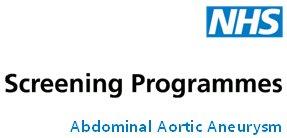Screening with elective repair of asymptomatic abdominal aortic aneurysms (AAA)
The main aim of screening is to detect aneurysms before rupture in order to either electively repair them (in large aneurysms) or surveillance (for small aneurysms) (1)
- ultrasound is the preferred tool for screening and surveillance
- benefit of screening is greatest in persons with major risk factors e.g. - male sex, increased age, and history of smoking, family history (1,2)
Several studies have reported the advantage of screening for AAA
- strongest evidence is seen in men over 65 years
- Cochrane review of four large randomised controlled trials reported that
- screening was associated with a significant decrease in AAA rupture and aneurysm related mortality for men aged 65-79 but not in women
- a further meta analysis of trials observing long term follow up (≥10 years) also reported a decreased mortality due to aneurysms and a trend towards reduced all cause of mortality (thought to be due to risk factor management) (1)
- Cochrane review of four large randomised controlled trials reported that
The optimum age at which screening should be carried out is unknown. Majority of trials carried out screening people over the age of 65 years.
- the UK National Health Service AAA Screening Programme (NAAASP) has reported that
- the risk of developing a new AAA after a single negative screening ultrasound scan in this group is small.
- a single cohort study reported that of 2691 men aged 64-81 with aortic diameters less than 3 cm on ultrasound, only two had died from ruptured AAA after 10 years
- in contrast, a randomised screening trial of 4308 men suggested that a subgroup of screened people with aortic diameters less than 3 cm may still be at risk of aneurysmal formation
- in this cohort , 120 (2.8%) developed an AAA over the next 10 years (1)
- the risk of developing a new AAA after a single negative screening ultrasound scan in this group is small.
Few countries have implemented national screening policies and the targeted populations are inconsistent.
- in England, the NHS abdominal aortic aneurysm (AAA) screening programme is available for all men aged 65 and over
- in the US, the U.S. Preventive Services Task Force guidelines recommends
- a onetime screening in men 65 to 75 years of age who have ever smoked
- selective screening in men 65 to 75 years of age who have never smoked
- although in earlier guidelines screening of women was not recommended, the 2014 guideline has been updated to suggest that the benefit of screening in women 65 to 75 years of age with a history of smoking is inconclusive (2,3)
NICE have stated with respect to identifying people at risk of abdominal aortic aneurysms (1):
Inform all men aged 66 or over who have not already been screened about the NHS abdominal aortic aneurysm (AAA) screening programme, and advise them that they can self-refer.
Encourage men aged 66 or over to self-refer to the NHS AAA screening programme if they have not already been screened and they have any of the following risk factors:
- chronic obstructive pulmonary disease (COPD)
- coronary, cerebrovascular or peripheral arterial disease
- family history of AAA
- hyperlipidaemia
- hypertension
- they smoke or used to smoke
Consider an aortic ultrasound for women aged 70 and over if AAA has not already been excluded on abdominal imaging and they have any of the following risk factors:
- COPD
- coronary, cerebrovascular or peripheral arterial disease
- family history of AAA
- hyperlipidaemia
- hypertension
- they smoke or used to smoke
Be aware that people of European family origin are at a higher risk of an AAA.

NHS AAA Screening Programme:
- the NHS Abdominal Aortic Aneurysm (AAA) Screening Programme now covers the whole of England. It was implemented in phases between 2009 and 2013. The programme invites all men in England for ultrasound screening during the year they turn 65. Men over 65 who have not been previously screened or diagnosed with an aneurysm can self-refer directly to the programme without going through their GP. Contact details for the local AAA screening services in England can be found at http://aaa.screening.nhs.uk/whereyoulive
- research has demonstrated that offering men ultrasound screening in their 65th year could reduce the rate of premature death from ruptured AAA by up to 50 per cent
- further information is available on the website:aaa.screening.nhs.uk
- a factsheet for GPs is downloadable from this link
- screening for AAA can currently produce one of four possible results;
- a normal size aorta measuring less than 3cm in diameter (no further screening is required)
- a small aneurysm measuring between 3.0-4.4 cm (no treatment required but annual scans offered)
- a medium aneurysm measuring between 4.5-5.4 cm (no treatment required but three monthly scans offered)
- a large aneurysms measuring 5.5 cm or larger (referred to a vascular surgeon; possible surgery) (3)
Screening for AAA may have negative effects as well. These include:
- morbidity and mortality associated with elective repair
- open repair has a mortality rate of 4.2% and a complication rate of 32%
- an impact on local vascular services due to increased number of elective repairs after introduction of screening
- patient anxiety and reduced quality of life for short periods after diagnosis (1,2)
Reference:
- (1) Metcalfe D, Holt PJ, Thompson MM. The management of abdominal aortic aneurysms. BMJ. 2011;342:d1384.
- (2) Keisler B, Carter C. Abdominal aortic aneurysm. Am Fam Physician. 2015;91(8):538-43.
- (3) UK National Screening Committee (2017). The UK NSC recommendation on Abdominal Aortic Aneurysm screening in men over 65
- (4) NICE (March 2020).Abdominal aortic aneurysm: diagnosis and management
Related pages
Create an account to add page annotations
Annotations allow you to add information to this page that would be handy to have on hand during a consultation. E.g. a website or number. This information will always show when you visit this page.